Applied Financial Planning (FPC002): Client Services & Obligations
VerifiedAdded on 2023/06/03
|44
|18268
|379
Report
AI Summary
This assignment focuses on outlining the initial and ongoing financial planning services provided to clients, specifically Simon and Nadia Johnson. It details the role of a financial advisor, including the services offered and the remuneration structure, ensuring FOFA compliance. The assignment explains the financial planning process, emphasizing the steps taken to provide the best advice and meet financial planning obligations. It also covers potential problems arising from non-compliance and the recourse available to clients in case of disputes. The assignment provides a verbal response to the clients, addressing their concerns and explaining the services in a clear and understandable manner.
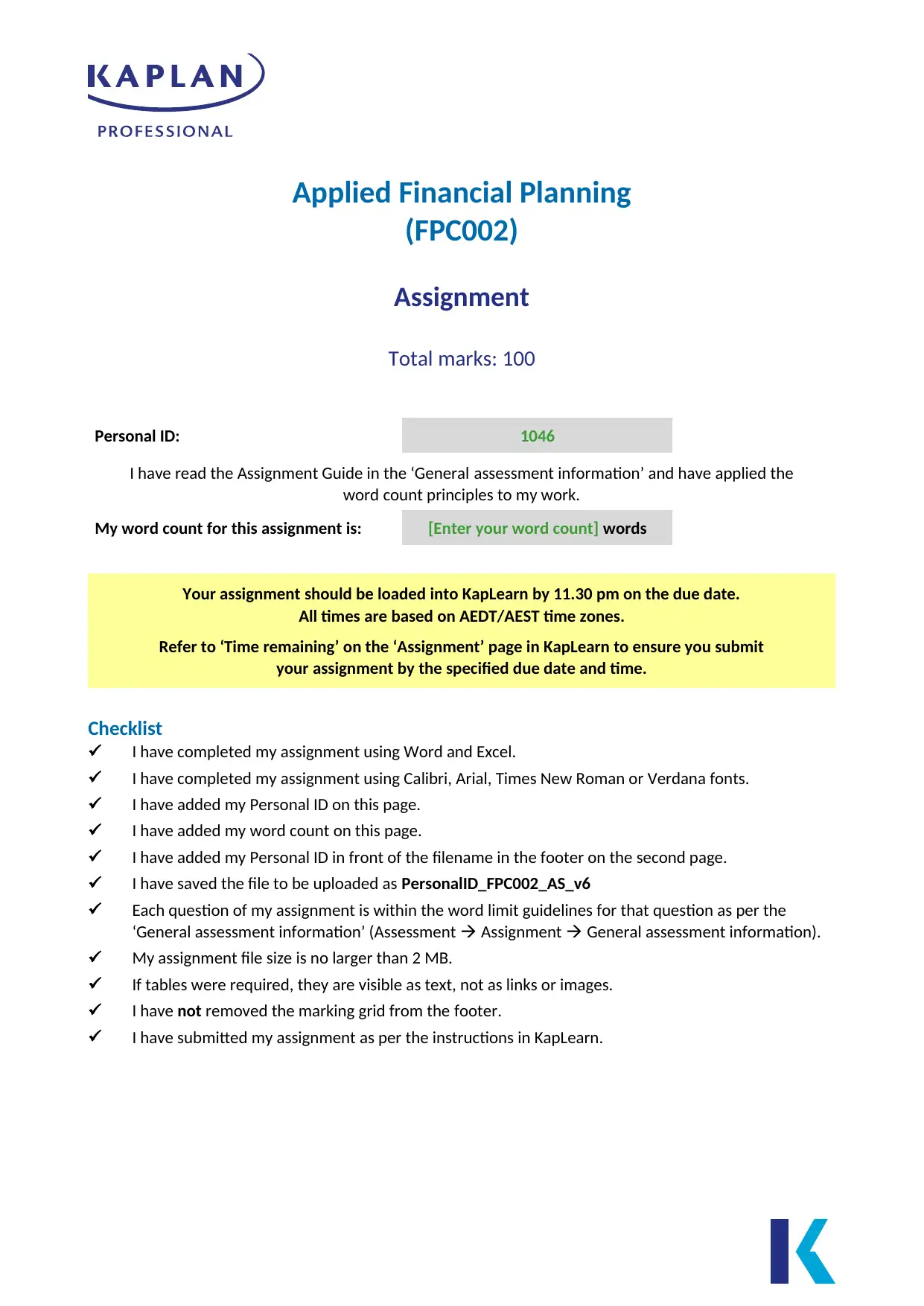
Applied Financial Planning
(FPC002)
Assignment
Total marks: 100
Personal ID: 1046
I have read the Assignment Guide in the ‘General assessment information’ and have applied the
word count principles to my work.
My word count for this assignment is: [Enter your word count] words
Your assignment should be loaded into KapLearn by 11.30 pm on the due date.
All times are based on AEDT/AEST time zones.
Refer to ‘Time remaining’ on the ‘Assignment’ page in KapLearn to ensure you submit
your assignment by the specified due date and time.
Checklist
I have completed my assignment using Word and Excel.
I have completed my assignment using Calibri, Arial, Times New Roman or Verdana fonts.
I have added my Personal ID on this page.
I have added my word count on this page.
I have added my Personal ID in front of the filename in the footer on the second page.
I have saved the file to be uploaded as PersonalID_FPC002_AS_v6
Each question of my assignment is within the word limit guidelines for that question as per the
‘General assessment information’ (Assessment Assignment General assessment information).
My assignment file size is no larger than 2 MB.
If tables were required, they are visible as text, not as links or images.
I have not removed the marking grid from the footer.
I have submitted my assignment as per the instructions in KapLearn.
(FPC002)
Assignment
Total marks: 100
Personal ID: 1046
I have read the Assignment Guide in the ‘General assessment information’ and have applied the
word count principles to my work.
My word count for this assignment is: [Enter your word count] words
Your assignment should be loaded into KapLearn by 11.30 pm on the due date.
All times are based on AEDT/AEST time zones.
Refer to ‘Time remaining’ on the ‘Assignment’ page in KapLearn to ensure you submit
your assignment by the specified due date and time.
Checklist
I have completed my assignment using Word and Excel.
I have completed my assignment using Calibri, Arial, Times New Roman or Verdana fonts.
I have added my Personal ID on this page.
I have added my word count on this page.
I have added my Personal ID in front of the filename in the footer on the second page.
I have saved the file to be uploaded as PersonalID_FPC002_AS_v6
Each question of my assignment is within the word limit guidelines for that question as per the
‘General assessment information’ (Assessment Assignment General assessment information).
My assignment file size is no larger than 2 MB.
If tables were required, they are visible as text, not as links or images.
I have not removed the marking grid from the footer.
I have submitted my assignment as per the instructions in KapLearn.
Paraphrase This Document
Need a fresh take? Get an instant paraphrase of this document with our AI Paraphraser

Marker feedback
Comment on overall performance:
For marker use only.
For office use only
Section A 1a 1b 1c 1d 1e 2a 2b(i) 2b(ii) 2c 2d(i) 2d(ii) 2d(iii)
Max 2 1 4 2 1 3 3 2 5 8 2 2
Awarded x x x x x x x x x x x x
Section B 3a 3b 3d 3e 3f 4 5a 5b(i) 5b(ii) 5c(i) 5c(ii) 5c(iii) 5c(iv) 5c(v) TOTAL
Max 5 5 3 7 5 10 3 6 2 5
5 5 2 2 **
Expres
sion is
faulty
**
Awarded x x x x x x x x x x
x x x x **
Expres
sion is
faulty
**
1046_FPC002_AS_v6 2 © Kaplan Higher Education
Comment on overall performance:
For marker use only.
For office use only
Section A 1a 1b 1c 1d 1e 2a 2b(i) 2b(ii) 2c 2d(i) 2d(ii) 2d(iii)
Max 2 1 4 2 1 3 3 2 5 8 2 2
Awarded x x x x x x x x x x x x
Section B 3a 3b 3d 3e 3f 4 5a 5b(i) 5b(ii) 5c(i) 5c(ii) 5c(iii) 5c(iv) 5c(v) TOTAL
Max 5 5 3 7 5 10 3 6 2 5
5 5 2 2 **
Expres
sion is
faulty
**
Awarded x x x x x x x x x x
x x x x **
Expres
sion is
faulty
**
1046_FPC002_AS_v6 2 © Kaplan Higher Education
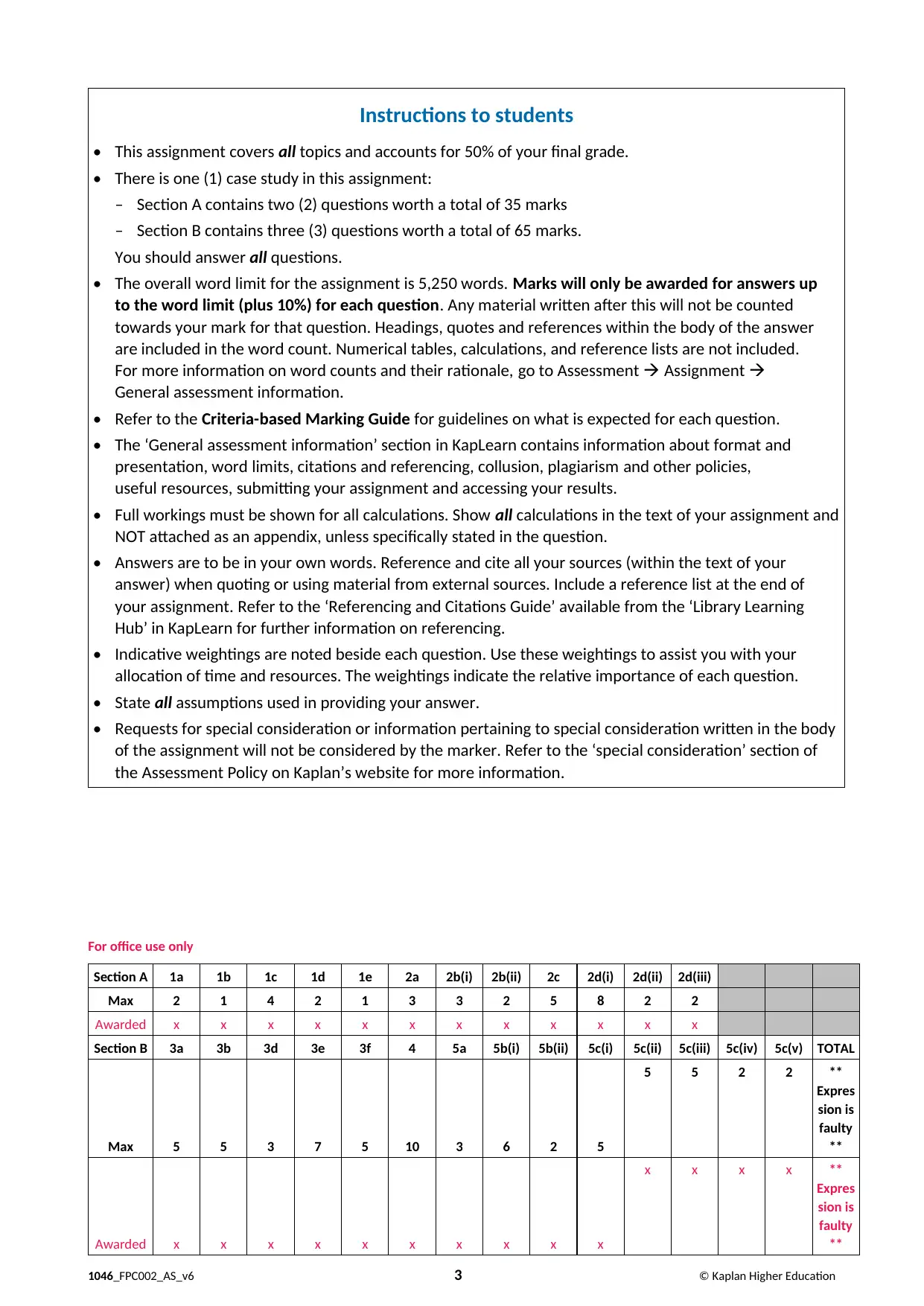
Instructions to students
• This assignment covers all topics and accounts for 50% of your final grade.
• There is one (1) case study in this assignment:
– Section A contains two (2) questions worth a total of 35 marks
– Section B contains three (3) questions worth a total of 65 marks.
You should answer all questions.
• The overall word limit for the assignment is 5,250 words. Marks will only be awarded for answers up
to the word limit (plus 10%) for each question. Any material written after this will not be counted
towards your mark for that question. Headings, quotes and references within the body of the answer
are included in the word count. Numerical tables, calculations, and reference lists are not included.
For more information on word counts and their rationale, go to Assessment Assignment
General assessment information.
• Refer to the Criteria-based Marking Guide for guidelines on what is expected for each question.
• The ‘General assessment information’ section in KapLearn contains information about format and
presentation, word limits, citations and referencing, collusion, plagiarism and other policies,
useful resources, submitting your assignment and accessing your results.
• Full workings must be shown for all calculations. Show all calculations in the text of your assignment and
NOT attached as an appendix, unless specifically stated in the question.
• Answers are to be in your own words. Reference and cite all your sources (within the text of your
answer) when quoting or using material from external sources. Include a reference list at the end of
your assignment. Refer to the ‘Referencing and Citations Guide’ available from the ‘Library Learning
Hub’ in KapLearn for further information on referencing.
• Indicative weightings are noted beside each question. Use these weightings to assist you with your
allocation of time and resources. The weightings indicate the relative importance of each question.
• State all assumptions used in providing your answer.
• Requests for special consideration or information pertaining to special consideration written in the body
of the assignment will not be considered by the marker. Refer to the ‘special consideration’ section of
the Assessment Policy on Kaplan’s website for more information.
For office use only
Section A 1a 1b 1c 1d 1e 2a 2b(i) 2b(ii) 2c 2d(i) 2d(ii) 2d(iii)
Max 2 1 4 2 1 3 3 2 5 8 2 2
Awarded x x x x x x x x x x x x
Section B 3a 3b 3d 3e 3f 4 5a 5b(i) 5b(ii) 5c(i) 5c(ii) 5c(iii) 5c(iv) 5c(v) TOTAL
Max 5 5 3 7 5 10 3 6 2 5
5 5 2 2 **
Expres
sion is
faulty
**
Awarded x x x x x x x x x x
x x x x **
Expres
sion is
faulty
**
1046_FPC002_AS_v6 3 © Kaplan Higher Education
• This assignment covers all topics and accounts for 50% of your final grade.
• There is one (1) case study in this assignment:
– Section A contains two (2) questions worth a total of 35 marks
– Section B contains three (3) questions worth a total of 65 marks.
You should answer all questions.
• The overall word limit for the assignment is 5,250 words. Marks will only be awarded for answers up
to the word limit (plus 10%) for each question. Any material written after this will not be counted
towards your mark for that question. Headings, quotes and references within the body of the answer
are included in the word count. Numerical tables, calculations, and reference lists are not included.
For more information on word counts and their rationale, go to Assessment Assignment
General assessment information.
• Refer to the Criteria-based Marking Guide for guidelines on what is expected for each question.
• The ‘General assessment information’ section in KapLearn contains information about format and
presentation, word limits, citations and referencing, collusion, plagiarism and other policies,
useful resources, submitting your assignment and accessing your results.
• Full workings must be shown for all calculations. Show all calculations in the text of your assignment and
NOT attached as an appendix, unless specifically stated in the question.
• Answers are to be in your own words. Reference and cite all your sources (within the text of your
answer) when quoting or using material from external sources. Include a reference list at the end of
your assignment. Refer to the ‘Referencing and Citations Guide’ available from the ‘Library Learning
Hub’ in KapLearn for further information on referencing.
• Indicative weightings are noted beside each question. Use these weightings to assist you with your
allocation of time and resources. The weightings indicate the relative importance of each question.
• State all assumptions used in providing your answer.
• Requests for special consideration or information pertaining to special consideration written in the body
of the assignment will not be considered by the marker. Refer to the ‘special consideration’ section of
the Assessment Policy on Kaplan’s website for more information.
For office use only
Section A 1a 1b 1c 1d 1e 2a 2b(i) 2b(ii) 2c 2d(i) 2d(ii) 2d(iii)
Max 2 1 4 2 1 3 3 2 5 8 2 2
Awarded x x x x x x x x x x x x
Section B 3a 3b 3d 3e 3f 4 5a 5b(i) 5b(ii) 5c(i) 5c(ii) 5c(iii) 5c(iv) 5c(v) TOTAL
Max 5 5 3 7 5 10 3 6 2 5
5 5 2 2 **
Expres
sion is
faulty
**
Awarded x x x x x x x x x x
x x x x **
Expres
sion is
faulty
**
1046_FPC002_AS_v6 3 © Kaplan Higher Education
⊘ This is a preview!⊘
Do you want full access?
Subscribe today to unlock all pages.

Trusted by 1+ million students worldwide
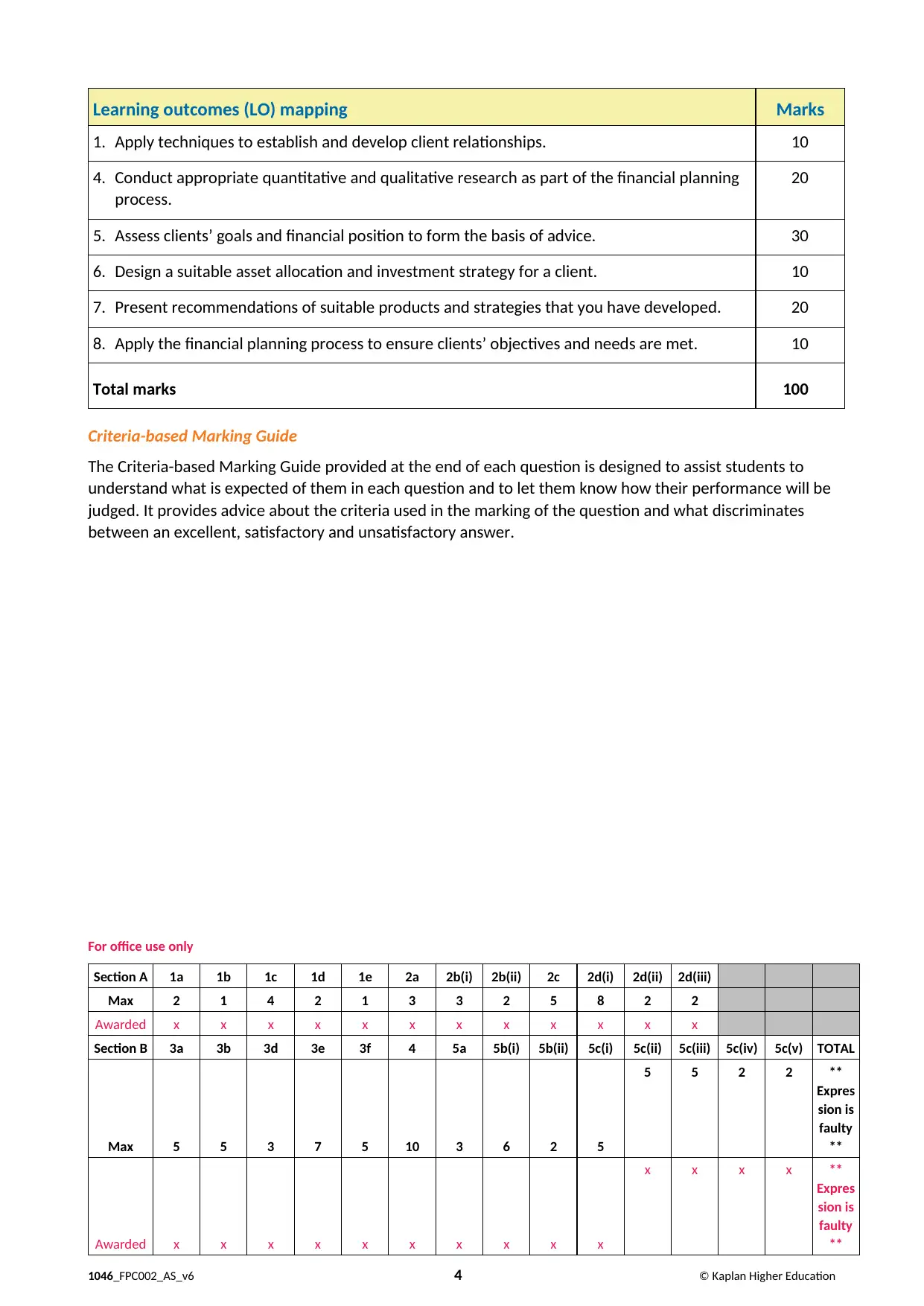
Learning outcomes (LO) mapping Marks
1. Apply techniques to establish and develop client relationships. 10
4. Conduct appropriate quantitative and qualitative research as part of the financial planning
process.
20
5. Assess clients’ goals and financial position to form the basis of advice. 30
6. Design a suitable asset allocation and investment strategy for a client. 10
7. Present recommendations of suitable products and strategies that you have developed. 20
8. Apply the financial planning process to ensure clients’ objectives and needs are met. 10
Total marks 100
Criteria-based Marking Guide
The Criteria-based Marking Guide provided at the end of each question is designed to assist students to
understand what is expected of them in each question and to let them know how their performance will be
judged. It provides advice about the criteria used in the marking of the question and what discriminates
between an excellent, satisfactory and unsatisfactory answer.
For office use only
Section A 1a 1b 1c 1d 1e 2a 2b(i) 2b(ii) 2c 2d(i) 2d(ii) 2d(iii)
Max 2 1 4 2 1 3 3 2 5 8 2 2
Awarded x x x x x x x x x x x x
Section B 3a 3b 3d 3e 3f 4 5a 5b(i) 5b(ii) 5c(i) 5c(ii) 5c(iii) 5c(iv) 5c(v) TOTAL
Max 5 5 3 7 5 10 3 6 2 5
5 5 2 2 **
Expres
sion is
faulty
**
Awarded x x x x x x x x x x
x x x x **
Expres
sion is
faulty
**
1046_FPC002_AS_v6 4 © Kaplan Higher Education
1. Apply techniques to establish and develop client relationships. 10
4. Conduct appropriate quantitative and qualitative research as part of the financial planning
process.
20
5. Assess clients’ goals and financial position to form the basis of advice. 30
6. Design a suitable asset allocation and investment strategy for a client. 10
7. Present recommendations of suitable products and strategies that you have developed. 20
8. Apply the financial planning process to ensure clients’ objectives and needs are met. 10
Total marks 100
Criteria-based Marking Guide
The Criteria-based Marking Guide provided at the end of each question is designed to assist students to
understand what is expected of them in each question and to let them know how their performance will be
judged. It provides advice about the criteria used in the marking of the question and what discriminates
between an excellent, satisfactory and unsatisfactory answer.
For office use only
Section A 1a 1b 1c 1d 1e 2a 2b(i) 2b(ii) 2c 2d(i) 2d(ii) 2d(iii)
Max 2 1 4 2 1 3 3 2 5 8 2 2
Awarded x x x x x x x x x x x x
Section B 3a 3b 3d 3e 3f 4 5a 5b(i) 5b(ii) 5c(i) 5c(ii) 5c(iii) 5c(iv) 5c(v) TOTAL
Max 5 5 3 7 5 10 3 6 2 5
5 5 2 2 **
Expres
sion is
faulty
**
Awarded x x x x x x x x x x
x x x x **
Expres
sion is
faulty
**
1046_FPC002_AS_v6 4 © Kaplan Higher Education
Paraphrase This Document
Need a fresh take? Get an instant paraphrase of this document with our AI Paraphraser
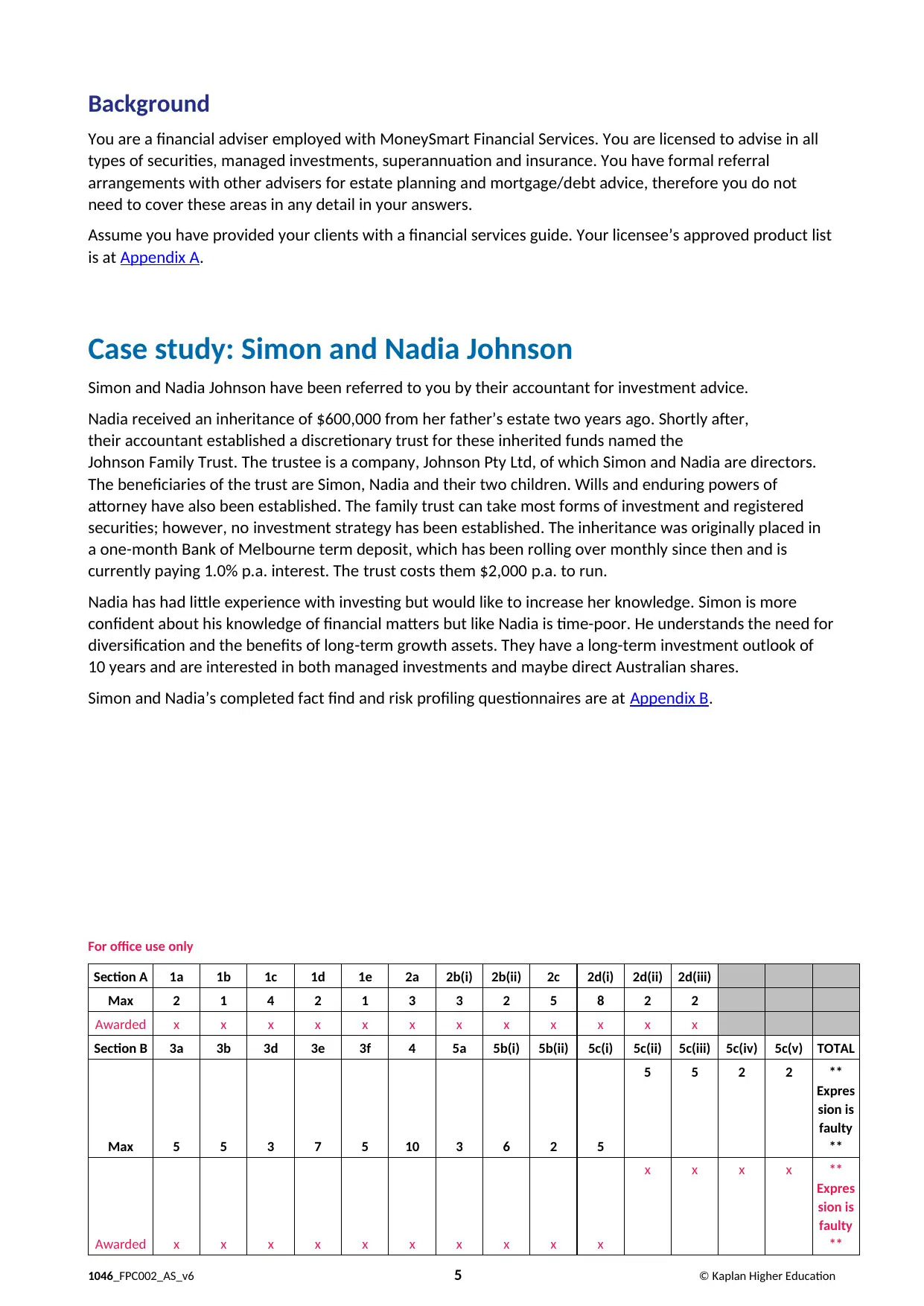
Background
You are a financial adviser employed with MoneySmart Financial Services. You are licensed to advise in all
types of securities, managed investments, superannuation and insurance. You have formal referral
arrangements with other advisers for estate planning and mortgage/debt advice, therefore you do not
need to cover these areas in any detail in your answers.
Assume you have provided your clients with a financial services guide. Your licensee’s approved product list
is at Appendix A.
Case study: Simon and Nadia Johnson
Simon and Nadia Johnson have been referred to you by their accountant for investment advice.
Nadia received an inheritance of $600,000 from her father’s estate two years ago. Shortly after,
their accountant established a discretionary trust for these inherited funds named the
Johnson Family Trust. The trustee is a company, Johnson Pty Ltd, of which Simon and Nadia are directors.
The beneficiaries of the trust are Simon, Nadia and their two children. Wills and enduring powers of
attorney have also been established. The family trust can take most forms of investment and registered
securities; however, no investment strategy has been established. The inheritance was originally placed in
a one-month Bank of Melbourne term deposit, which has been rolling over monthly since then and is
currently paying 1.0% p.a. interest. The trust costs them $2,000 p.a. to run.
Nadia has had little experience with investing but would like to increase her knowledge. Simon is more
confident about his knowledge of financial matters but like Nadia is time-poor. He understands the need for
diversification and the benefits of long-term growth assets. They have a long-term investment outlook of
10 years and are interested in both managed investments and maybe direct Australian shares.
Simon and Nadia’s completed fact find and risk profiling questionnaires are at Appendix B.
For office use only
Section A 1a 1b 1c 1d 1e 2a 2b(i) 2b(ii) 2c 2d(i) 2d(ii) 2d(iii)
Max 2 1 4 2 1 3 3 2 5 8 2 2
Awarded x x x x x x x x x x x x
Section B 3a 3b 3d 3e 3f 4 5a 5b(i) 5b(ii) 5c(i) 5c(ii) 5c(iii) 5c(iv) 5c(v) TOTAL
Max 5 5 3 7 5 10 3 6 2 5
5 5 2 2 **
Expres
sion is
faulty
**
Awarded x x x x x x x x x x
x x x x **
Expres
sion is
faulty
**
1046_FPC002_AS_v6 5 © Kaplan Higher Education
You are a financial adviser employed with MoneySmart Financial Services. You are licensed to advise in all
types of securities, managed investments, superannuation and insurance. You have formal referral
arrangements with other advisers for estate planning and mortgage/debt advice, therefore you do not
need to cover these areas in any detail in your answers.
Assume you have provided your clients with a financial services guide. Your licensee’s approved product list
is at Appendix A.
Case study: Simon and Nadia Johnson
Simon and Nadia Johnson have been referred to you by their accountant for investment advice.
Nadia received an inheritance of $600,000 from her father’s estate two years ago. Shortly after,
their accountant established a discretionary trust for these inherited funds named the
Johnson Family Trust. The trustee is a company, Johnson Pty Ltd, of which Simon and Nadia are directors.
The beneficiaries of the trust are Simon, Nadia and their two children. Wills and enduring powers of
attorney have also been established. The family trust can take most forms of investment and registered
securities; however, no investment strategy has been established. The inheritance was originally placed in
a one-month Bank of Melbourne term deposit, which has been rolling over monthly since then and is
currently paying 1.0% p.a. interest. The trust costs them $2,000 p.a. to run.
Nadia has had little experience with investing but would like to increase her knowledge. Simon is more
confident about his knowledge of financial matters but like Nadia is time-poor. He understands the need for
diversification and the benefits of long-term growth assets. They have a long-term investment outlook of
10 years and are interested in both managed investments and maybe direct Australian shares.
Simon and Nadia’s completed fact find and risk profiling questionnaires are at Appendix B.
For office use only
Section A 1a 1b 1c 1d 1e 2a 2b(i) 2b(ii) 2c 2d(i) 2d(ii) 2d(iii)
Max 2 1 4 2 1 3 3 2 5 8 2 2
Awarded x x x x x x x x x x x x
Section B 3a 3b 3d 3e 3f 4 5a 5b(i) 5b(ii) 5c(i) 5c(ii) 5c(iii) 5c(iv) 5c(v) TOTAL
Max 5 5 3 7 5 10 3 6 2 5
5 5 2 2 **
Expres
sion is
faulty
**
Awarded x x x x x x x x x x
x x x x **
Expres
sion is
faulty
**
1046_FPC002_AS_v6 5 © Kaplan Higher Education
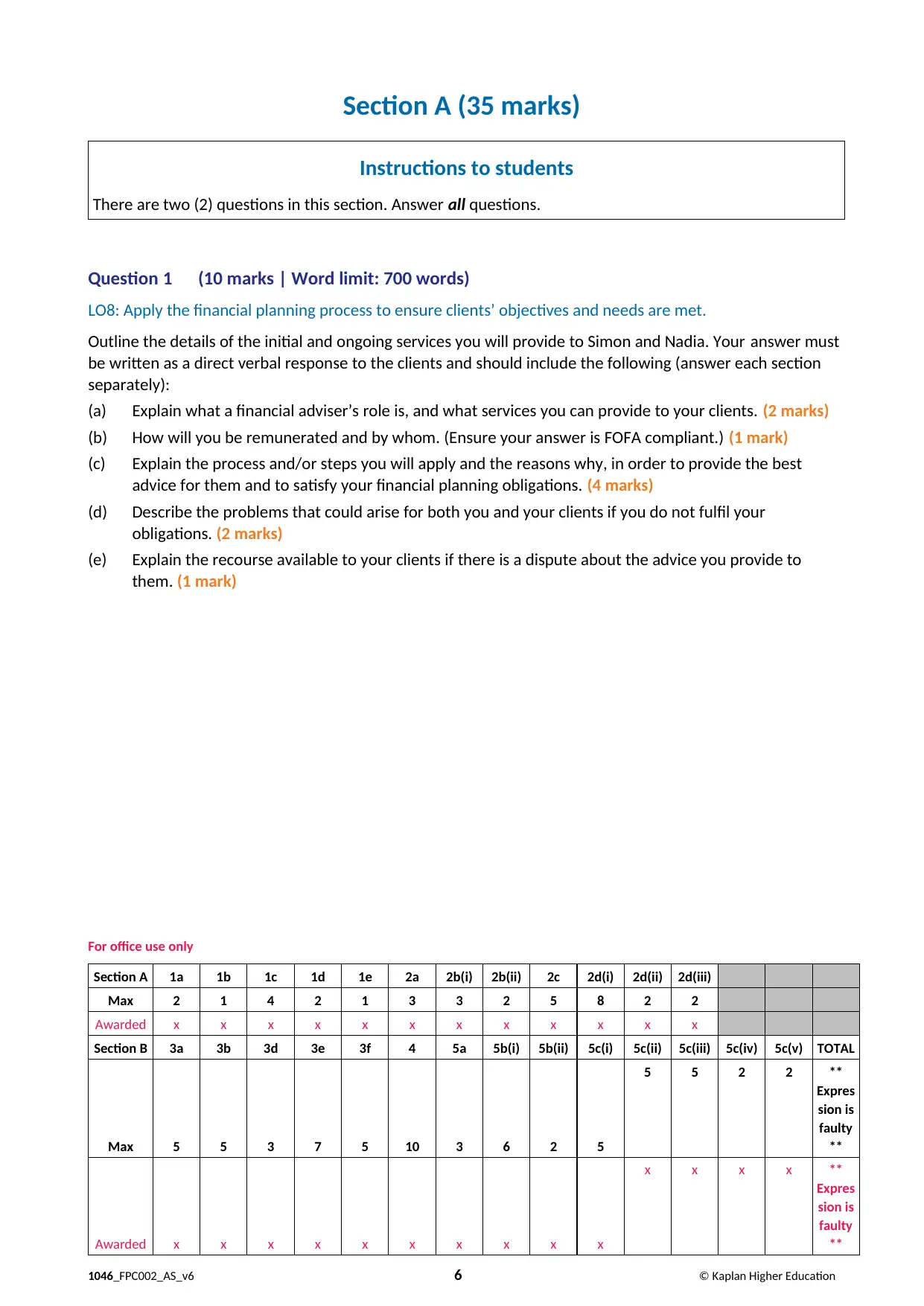
Section A (35 marks)
Instructions to students
There are two (2) questions in this section. Answer all questions.
Question 1 (10 marks | Word limit: 700 words)
LO8: Apply the financial planning process to ensure clients’ objectives and needs are met.
Outline the details of the initial and ongoing services you will provide to Simon and Nadia. Your answer must
be written as a direct verbal response to the clients and should include the following (answer each section
separately):
(a) Explain what a financial adviser’s role is, and what services you can provide to your clients. (2 marks)
(b) How will you be remunerated and by whom. (Ensure your answer is FOFA compliant.) (1 mark)
(c) Explain the process and/or steps you will apply and the reasons why, in order to provide the best
advice for them and to satisfy your financial planning obligations. (4 marks)
(d) Describe the problems that could arise for both you and your clients if you do not fulfil your
obligations. (2 marks)
(e) Explain the recourse available to your clients if there is a dispute about the advice you provide to
them. (1 mark)
For office use only
Section A 1a 1b 1c 1d 1e 2a 2b(i) 2b(ii) 2c 2d(i) 2d(ii) 2d(iii)
Max 2 1 4 2 1 3 3 2 5 8 2 2
Awarded x x x x x x x x x x x x
Section B 3a 3b 3d 3e 3f 4 5a 5b(i) 5b(ii) 5c(i) 5c(ii) 5c(iii) 5c(iv) 5c(v) TOTAL
Max 5 5 3 7 5 10 3 6 2 5
5 5 2 2 **
Expres
sion is
faulty
**
Awarded x x x x x x x x x x
x x x x **
Expres
sion is
faulty
**
1046_FPC002_AS_v6 6 © Kaplan Higher Education
Instructions to students
There are two (2) questions in this section. Answer all questions.
Question 1 (10 marks | Word limit: 700 words)
LO8: Apply the financial planning process to ensure clients’ objectives and needs are met.
Outline the details of the initial and ongoing services you will provide to Simon and Nadia. Your answer must
be written as a direct verbal response to the clients and should include the following (answer each section
separately):
(a) Explain what a financial adviser’s role is, and what services you can provide to your clients. (2 marks)
(b) How will you be remunerated and by whom. (Ensure your answer is FOFA compliant.) (1 mark)
(c) Explain the process and/or steps you will apply and the reasons why, in order to provide the best
advice for them and to satisfy your financial planning obligations. (4 marks)
(d) Describe the problems that could arise for both you and your clients if you do not fulfil your
obligations. (2 marks)
(e) Explain the recourse available to your clients if there is a dispute about the advice you provide to
them. (1 mark)
For office use only
Section A 1a 1b 1c 1d 1e 2a 2b(i) 2b(ii) 2c 2d(i) 2d(ii) 2d(iii)
Max 2 1 4 2 1 3 3 2 5 8 2 2
Awarded x x x x x x x x x x x x
Section B 3a 3b 3d 3e 3f 4 5a 5b(i) 5b(ii) 5c(i) 5c(ii) 5c(iii) 5c(iv) 5c(v) TOTAL
Max 5 5 3 7 5 10 3 6 2 5
5 5 2 2 **
Expres
sion is
faulty
**
Awarded x x x x x x x x x x
x x x x **
Expres
sion is
faulty
**
1046_FPC002_AS_v6 6 © Kaplan Higher Education
⊘ This is a preview!⊘
Do you want full access?
Subscribe today to unlock all pages.

Trusted by 1+ million students worldwide
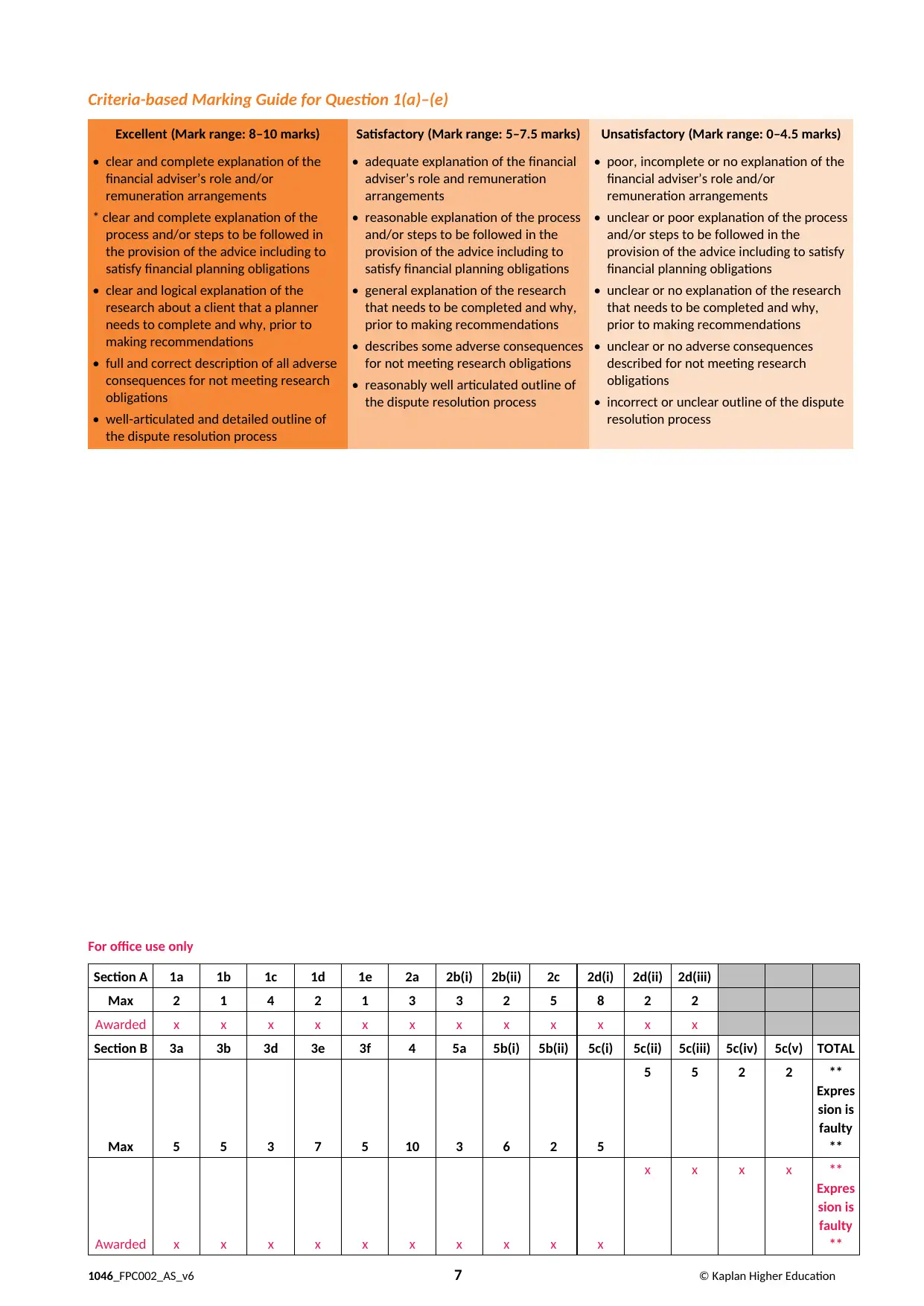
Criteria-based Marking Guide for Question 1(a)–(e)
Excellent (Mark range: 8–10 marks) Satisfactory (Mark range: 5–7.5 marks) Unsatisfactory (Mark range: 0–4.5 marks)
• clear and complete explanation of the
financial adviser’s role and/or
remuneration arrangements
* clear and complete explanation of the
process and/or steps to be followed in
the provision of the advice including to
satisfy financial planning obligations
• clear and logical explanation of the
research about a client that a planner
needs to complete and why, prior to
making recommendations
• full and correct description of all adverse
consequences for not meeting research
obligations
• well-articulated and detailed outline of
the dispute resolution process
• adequate explanation of the financial
adviser’s role and remuneration
arrangements
• reasonable explanation of the process
and/or steps to be followed in the
provision of the advice including to
satisfy financial planning obligations
• general explanation of the research
that needs to be completed and why,
prior to making recommendations
• describes some adverse consequences
for not meeting research obligations
• reasonably well articulated outline of
the dispute resolution process
• poor, incomplete or no explanation of the
financial adviser’s role and/or
remuneration arrangements
• unclear or poor explanation of the process
and/or steps to be followed in the
provision of the advice including to satisfy
financial planning obligations
• unclear or no explanation of the research
that needs to be completed and why,
prior to making recommendations
• unclear or no adverse consequences
described for not meeting research
obligations
• incorrect or unclear outline of the dispute
resolution process
For office use only
Section A 1a 1b 1c 1d 1e 2a 2b(i) 2b(ii) 2c 2d(i) 2d(ii) 2d(iii)
Max 2 1 4 2 1 3 3 2 5 8 2 2
Awarded x x x x x x x x x x x x
Section B 3a 3b 3d 3e 3f 4 5a 5b(i) 5b(ii) 5c(i) 5c(ii) 5c(iii) 5c(iv) 5c(v) TOTAL
Max 5 5 3 7 5 10 3 6 2 5
5 5 2 2 **
Expres
sion is
faulty
**
Awarded x x x x x x x x x x
x x x x **
Expres
sion is
faulty
**
1046_FPC002_AS_v6 7 © Kaplan Higher Education
Excellent (Mark range: 8–10 marks) Satisfactory (Mark range: 5–7.5 marks) Unsatisfactory (Mark range: 0–4.5 marks)
• clear and complete explanation of the
financial adviser’s role and/or
remuneration arrangements
* clear and complete explanation of the
process and/or steps to be followed in
the provision of the advice including to
satisfy financial planning obligations
• clear and logical explanation of the
research about a client that a planner
needs to complete and why, prior to
making recommendations
• full and correct description of all adverse
consequences for not meeting research
obligations
• well-articulated and detailed outline of
the dispute resolution process
• adequate explanation of the financial
adviser’s role and remuneration
arrangements
• reasonable explanation of the process
and/or steps to be followed in the
provision of the advice including to
satisfy financial planning obligations
• general explanation of the research
that needs to be completed and why,
prior to making recommendations
• describes some adverse consequences
for not meeting research obligations
• reasonably well articulated outline of
the dispute resolution process
• poor, incomplete or no explanation of the
financial adviser’s role and/or
remuneration arrangements
• unclear or poor explanation of the process
and/or steps to be followed in the
provision of the advice including to satisfy
financial planning obligations
• unclear or no explanation of the research
that needs to be completed and why,
prior to making recommendations
• unclear or no adverse consequences
described for not meeting research
obligations
• incorrect or unclear outline of the dispute
resolution process
For office use only
Section A 1a 1b 1c 1d 1e 2a 2b(i) 2b(ii) 2c 2d(i) 2d(ii) 2d(iii)
Max 2 1 4 2 1 3 3 2 5 8 2 2
Awarded x x x x x x x x x x x x
Section B 3a 3b 3d 3e 3f 4 5a 5b(i) 5b(ii) 5c(i) 5c(ii) 5c(iii) 5c(iv) 5c(v) TOTAL
Max 5 5 3 7 5 10 3 6 2 5
5 5 2 2 **
Expres
sion is
faulty
**
Awarded x x x x x x x x x x
x x x x **
Expres
sion is
faulty
**
1046_FPC002_AS_v6 7 © Kaplan Higher Education
Paraphrase This Document
Need a fresh take? Get an instant paraphrase of this document with our AI Paraphraser
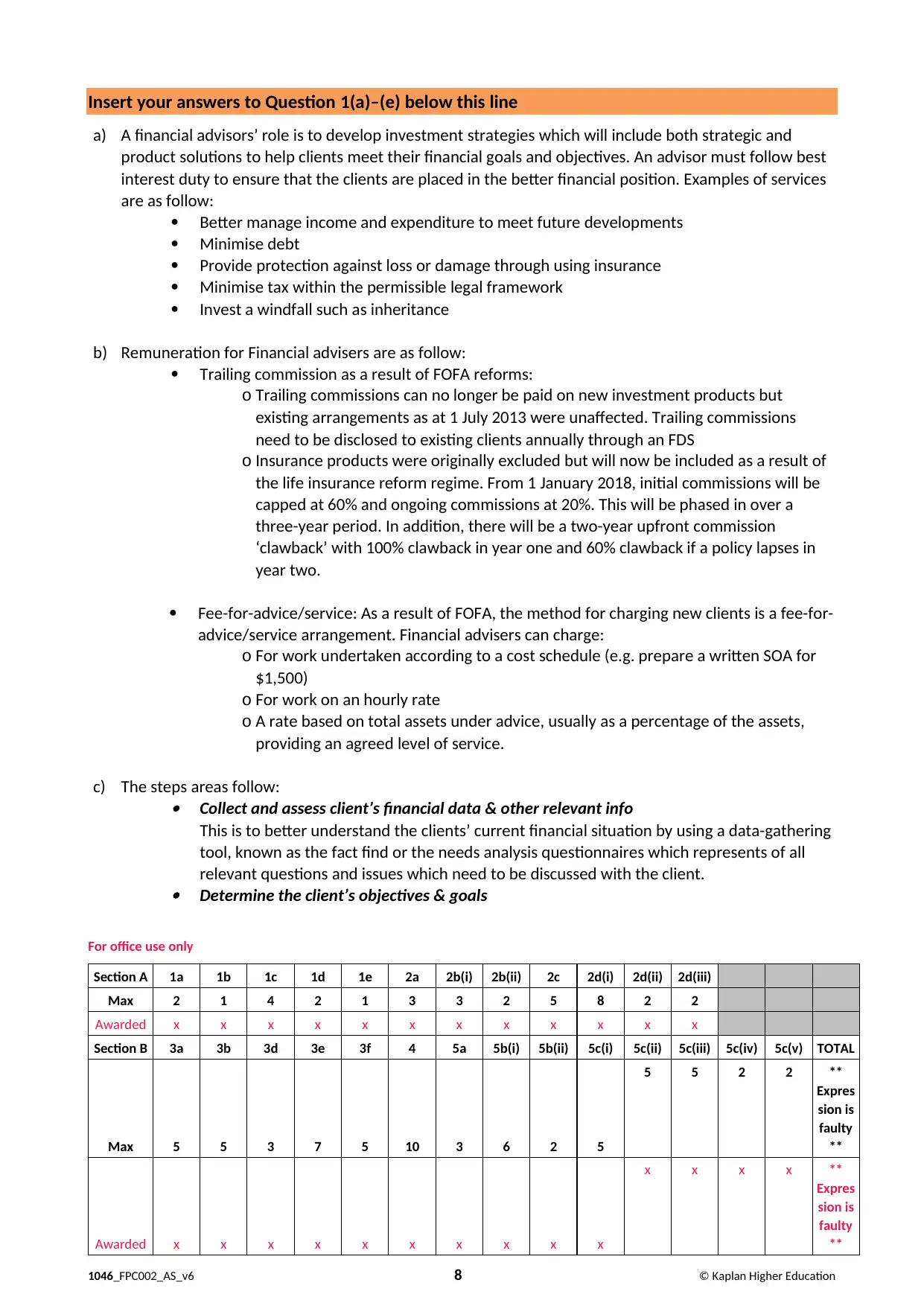
Insert your answers to Question 1(a)–(e) below this line
a) A financial advisors’ role is to develop investment strategies which will include both strategic and
product solutions to help clients meet their financial goals and objectives. An advisor must follow best
interest duty to ensure that the clients are placed in the better financial position. Examples of services
are as follow:
Better manage income and expenditure to meet future developments
Minimise debt
Provide protection against loss or damage through using insurance
Minimise tax within the permissible legal framework
Invest a windfall such as inheritance
b) Remuneration for Financial advisers are as follow:
Trailing commission as a result of FOFA reforms:
o Trailing commissions can no longer be paid on new investment products but
existing arrangements as at 1 July 2013 were unaffected. Trailing commissions
need to be disclosed to existing clients annually through an FDS
o Insurance products were originally excluded but will now be included as a result of
the life insurance reform regime. From 1 January 2018, initial commissions will be
capped at 60% and ongoing commissions at 20%. This will be phased in over a
three-year period. In addition, there will be a two-year upfront commission
‘clawback’ with 100% clawback in year one and 60% clawback if a policy lapses in
year two.
Fee-for-advice/service: As a result of FOFA, the method for charging new clients is a fee-for-
advice/service arrangement. Financial advisers can charge:
o For work undertaken according to a cost schedule (e.g. prepare a written SOA for
$1,500)
o For work on an hourly rate
o A rate based on total assets under advice, usually as a percentage of the assets,
providing an agreed level of service.
c) The steps areas follow:
Collect and assess client’s financial data & other relevant info
This is to better understand the clients’ current financial situation by using a data-gathering
tool, known as the fact find or the needs analysis questionnaires which represents of all
relevant questions and issues which need to be discussed with the client.
Determine the client’s objectives & goals
For office use only
Section A 1a 1b 1c 1d 1e 2a 2b(i) 2b(ii) 2c 2d(i) 2d(ii) 2d(iii)
Max 2 1 4 2 1 3 3 2 5 8 2 2
Awarded x x x x x x x x x x x x
Section B 3a 3b 3d 3e 3f 4 5a 5b(i) 5b(ii) 5c(i) 5c(ii) 5c(iii) 5c(iv) 5c(v) TOTAL
Max 5 5 3 7 5 10 3 6 2 5
5 5 2 2 **
Expres
sion is
faulty
**
Awarded x x x x x x x x x x
x x x x **
Expres
sion is
faulty
**
1046_FPC002_AS_v6 8 © Kaplan Higher Education
a) A financial advisors’ role is to develop investment strategies which will include both strategic and
product solutions to help clients meet their financial goals and objectives. An advisor must follow best
interest duty to ensure that the clients are placed in the better financial position. Examples of services
are as follow:
Better manage income and expenditure to meet future developments
Minimise debt
Provide protection against loss or damage through using insurance
Minimise tax within the permissible legal framework
Invest a windfall such as inheritance
b) Remuneration for Financial advisers are as follow:
Trailing commission as a result of FOFA reforms:
o Trailing commissions can no longer be paid on new investment products but
existing arrangements as at 1 July 2013 were unaffected. Trailing commissions
need to be disclosed to existing clients annually through an FDS
o Insurance products were originally excluded but will now be included as a result of
the life insurance reform regime. From 1 January 2018, initial commissions will be
capped at 60% and ongoing commissions at 20%. This will be phased in over a
three-year period. In addition, there will be a two-year upfront commission
‘clawback’ with 100% clawback in year one and 60% clawback if a policy lapses in
year two.
Fee-for-advice/service: As a result of FOFA, the method for charging new clients is a fee-for-
advice/service arrangement. Financial advisers can charge:
o For work undertaken according to a cost schedule (e.g. prepare a written SOA for
$1,500)
o For work on an hourly rate
o A rate based on total assets under advice, usually as a percentage of the assets,
providing an agreed level of service.
c) The steps areas follow:
Collect and assess client’s financial data & other relevant info
This is to better understand the clients’ current financial situation by using a data-gathering
tool, known as the fact find or the needs analysis questionnaires which represents of all
relevant questions and issues which need to be discussed with the client.
Determine the client’s objectives & goals
For office use only
Section A 1a 1b 1c 1d 1e 2a 2b(i) 2b(ii) 2c 2d(i) 2d(ii) 2d(iii)
Max 2 1 4 2 1 3 3 2 5 8 2 2
Awarded x x x x x x x x x x x x
Section B 3a 3b 3d 3e 3f 4 5a 5b(i) 5b(ii) 5c(i) 5c(ii) 5c(iii) 5c(iv) 5c(v) TOTAL
Max 5 5 3 7 5 10 3 6 2 5
5 5 2 2 **
Expres
sion is
faulty
**
Awarded x x x x x x x x x x
x x x x **
Expres
sion is
faulty
**
1046_FPC002_AS_v6 8 © Kaplan Higher Education

This provides crucial information as to the reason why the clients seek advice and their
financial aspirations. Failing to determine goals and objectives may lead to the adviser
making recommendations that do not align with the clients’ expectations.
For office use only
Section A 1a 1b 1c 1d 1e 2a 2b(i) 2b(ii) 2c 2d(i) 2d(ii) 2d(iii)
Max 2 1 4 2 1 3 3 2 5 8 2 2
Awarded x x x x x x x x x x x x
Section B 3a 3b 3d 3e 3f 4 5a 5b(i) 5b(ii) 5c(i) 5c(ii) 5c(iii) 5c(iv) 5c(v) TOTAL
Max 5 5 3 7 5 10 3 6 2 5
5 5 2 2 **
Expres
sion is
faulty
**
Awarded x x x x x x x x x x
x x x x **
Expres
sion is
faulty
**
1046_FPC002_AS_v6 9 © Kaplan Higher Education
financial aspirations. Failing to determine goals and objectives may lead to the adviser
making recommendations that do not align with the clients’ expectations.
For office use only
Section A 1a 1b 1c 1d 1e 2a 2b(i) 2b(ii) 2c 2d(i) 2d(ii) 2d(iii)
Max 2 1 4 2 1 3 3 2 5 8 2 2
Awarded x x x x x x x x x x x x
Section B 3a 3b 3d 3e 3f 4 5a 5b(i) 5b(ii) 5c(i) 5c(ii) 5c(iii) 5c(iv) 5c(v) TOTAL
Max 5 5 3 7 5 10 3 6 2 5
5 5 2 2 **
Expres
sion is
faulty
**
Awarded x x x x x x x x x x
x x x x **
Expres
sion is
faulty
**
1046_FPC002_AS_v6 9 © Kaplan Higher Education
⊘ This is a preview!⊘
Do you want full access?
Subscribe today to unlock all pages.

Trusted by 1+ million students worldwide
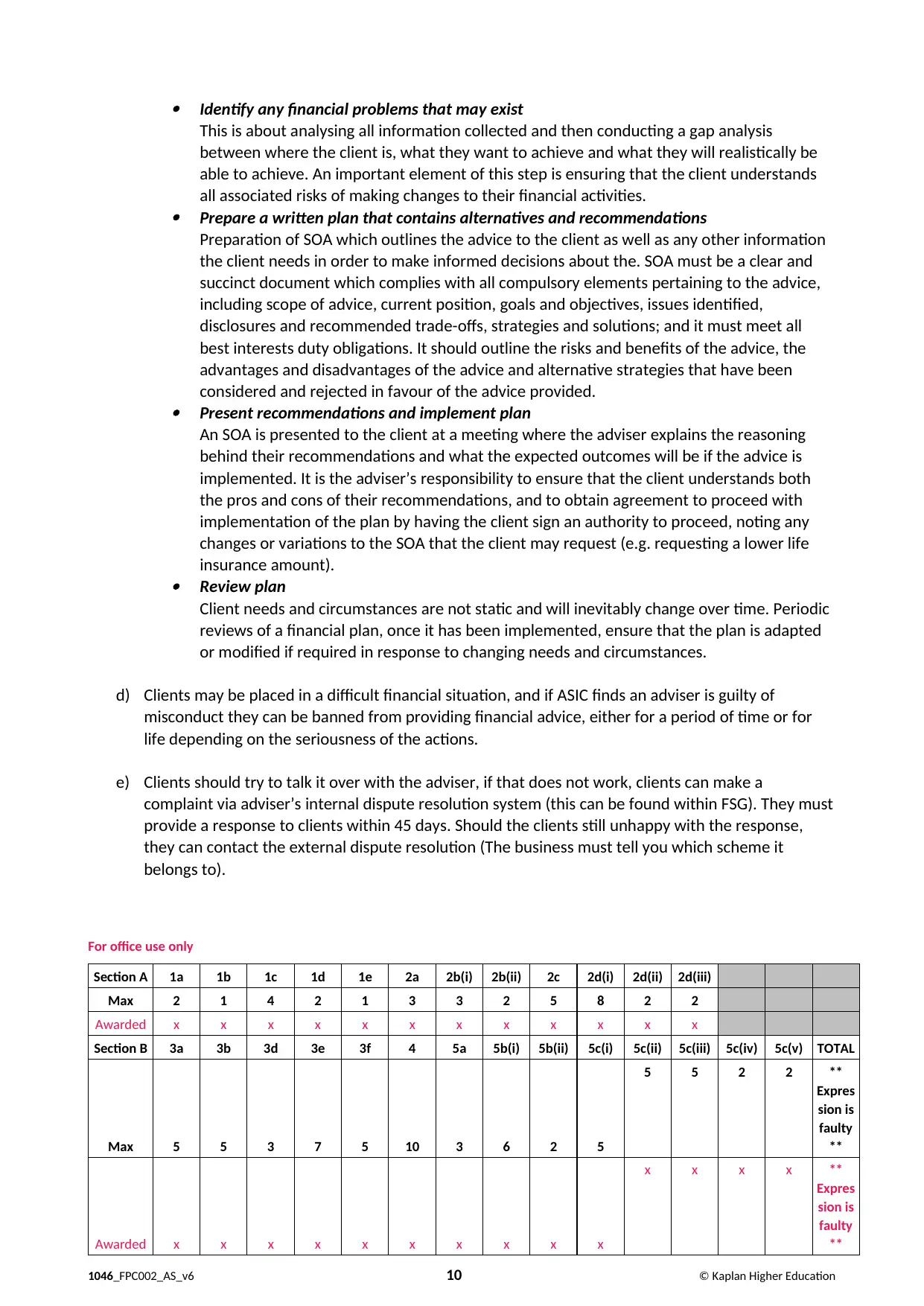
Identify any financial problems that may exist
This is about analysing all information collected and then conducting a gap analysis
between where the client is, what they want to achieve and what they will realistically be
able to achieve. An important element of this step is ensuring that the client understands
all associated risks of making changes to their financial activities.
Prepare a written plan that contains alternatives and recommendations
Preparation of SOA which outlines the advice to the client as well as any other information
the client needs in order to make informed decisions about the. SOA must be a clear and
succinct document which complies with all compulsory elements pertaining to the advice,
including scope of advice, current position, goals and objectives, issues identified,
disclosures and recommended trade-offs, strategies and solutions; and it must meet all
best interests duty obligations. It should outline the risks and benefits of the advice, the
advantages and disadvantages of the advice and alternative strategies that have been
considered and rejected in favour of the advice provided.
Present recommendations and implement plan
An SOA is presented to the client at a meeting where the adviser explains the reasoning
behind their recommendations and what the expected outcomes will be if the advice is
implemented. It is the adviser’s responsibility to ensure that the client understands both
the pros and cons of their recommendations, and to obtain agreement to proceed with
implementation of the plan by having the client sign an authority to proceed, noting any
changes or variations to the SOA that the client may request (e.g. requesting a lower life
insurance amount).
Review plan
Client needs and circumstances are not static and will inevitably change over time. Periodic
reviews of a financial plan, once it has been implemented, ensure that the plan is adapted
or modified if required in response to changing needs and circumstances.
d) Clients may be placed in a difficult financial situation, and if ASIC finds an adviser is guilty of
misconduct they can be banned from providing financial advice, either for a period of time or for
life depending on the seriousness of the actions.
e) Clients should try to talk it over with the adviser, if that does not work, clients can make a
complaint via adviser’s internal dispute resolution system (this can be found within FSG). They must
provide a response to clients within 45 days. Should the clients still unhappy with the response,
they can contact the external dispute resolution (The business must tell you which scheme it
belongs to).
For office use only
Section A 1a 1b 1c 1d 1e 2a 2b(i) 2b(ii) 2c 2d(i) 2d(ii) 2d(iii)
Max 2 1 4 2 1 3 3 2 5 8 2 2
Awarded x x x x x x x x x x x x
Section B 3a 3b 3d 3e 3f 4 5a 5b(i) 5b(ii) 5c(i) 5c(ii) 5c(iii) 5c(iv) 5c(v) TOTAL
Max 5 5 3 7 5 10 3 6 2 5
5 5 2 2 **
Expres
sion is
faulty
**
Awarded x x x x x x x x x x
x x x x **
Expres
sion is
faulty
**
1046_FPC002_AS_v6 10 © Kaplan Higher Education
This is about analysing all information collected and then conducting a gap analysis
between where the client is, what they want to achieve and what they will realistically be
able to achieve. An important element of this step is ensuring that the client understands
all associated risks of making changes to their financial activities.
Prepare a written plan that contains alternatives and recommendations
Preparation of SOA which outlines the advice to the client as well as any other information
the client needs in order to make informed decisions about the. SOA must be a clear and
succinct document which complies with all compulsory elements pertaining to the advice,
including scope of advice, current position, goals and objectives, issues identified,
disclosures and recommended trade-offs, strategies and solutions; and it must meet all
best interests duty obligations. It should outline the risks and benefits of the advice, the
advantages and disadvantages of the advice and alternative strategies that have been
considered and rejected in favour of the advice provided.
Present recommendations and implement plan
An SOA is presented to the client at a meeting where the adviser explains the reasoning
behind their recommendations and what the expected outcomes will be if the advice is
implemented. It is the adviser’s responsibility to ensure that the client understands both
the pros and cons of their recommendations, and to obtain agreement to proceed with
implementation of the plan by having the client sign an authority to proceed, noting any
changes or variations to the SOA that the client may request (e.g. requesting a lower life
insurance amount).
Review plan
Client needs and circumstances are not static and will inevitably change over time. Periodic
reviews of a financial plan, once it has been implemented, ensure that the plan is adapted
or modified if required in response to changing needs and circumstances.
d) Clients may be placed in a difficult financial situation, and if ASIC finds an adviser is guilty of
misconduct they can be banned from providing financial advice, either for a period of time or for
life depending on the seriousness of the actions.
e) Clients should try to talk it over with the adviser, if that does not work, clients can make a
complaint via adviser’s internal dispute resolution system (this can be found within FSG). They must
provide a response to clients within 45 days. Should the clients still unhappy with the response,
they can contact the external dispute resolution (The business must tell you which scheme it
belongs to).
For office use only
Section A 1a 1b 1c 1d 1e 2a 2b(i) 2b(ii) 2c 2d(i) 2d(ii) 2d(iii)
Max 2 1 4 2 1 3 3 2 5 8 2 2
Awarded x x x x x x x x x x x x
Section B 3a 3b 3d 3e 3f 4 5a 5b(i) 5b(ii) 5c(i) 5c(ii) 5c(iii) 5c(iv) 5c(v) TOTAL
Max 5 5 3 7 5 10 3 6 2 5
5 5 2 2 **
Expres
sion is
faulty
**
Awarded x x x x x x x x x x
x x x x **
Expres
sion is
faulty
**
1046_FPC002_AS_v6 10 © Kaplan Higher Education
Paraphrase This Document
Need a fresh take? Get an instant paraphrase of this document with our AI Paraphraser

Words: 810
End of answers to Question 1(a)–(e)
For office use only
Section A 1a 1b 1c 1d 1e 2a 2b(i) 2b(ii) 2c 2d(i) 2d(ii) 2d(iii)
Max 2 1 4 2 1 3 3 2 5 8 2 2
Awarded x x x x x x x x x x x x
Section B 3a 3b 3d 3e 3f 4 5a 5b(i) 5b(ii) 5c(i) 5c(ii) 5c(iii) 5c(iv) 5c(v) TOTAL
Max 5 5 3 7 5 10 3 6 2 5
5 5 2 2 **
Expres
sion is
faulty
**
Awarded x x x x x x x x x x
x x x x **
Expres
sion is
faulty
**
1046_FPC002_AS_v6 11 © Kaplan Higher Education
End of answers to Question 1(a)–(e)
For office use only
Section A 1a 1b 1c 1d 1e 2a 2b(i) 2b(ii) 2c 2d(i) 2d(ii) 2d(iii)
Max 2 1 4 2 1 3 3 2 5 8 2 2
Awarded x x x x x x x x x x x x
Section B 3a 3b 3d 3e 3f 4 5a 5b(i) 5b(ii) 5c(i) 5c(ii) 5c(iii) 5c(iv) 5c(v) TOTAL
Max 5 5 3 7 5 10 3 6 2 5
5 5 2 2 **
Expres
sion is
faulty
**
Awarded x x x x x x x x x x
x x x x **
Expres
sion is
faulty
**
1046_FPC002_AS_v6 11 © Kaplan Higher Education
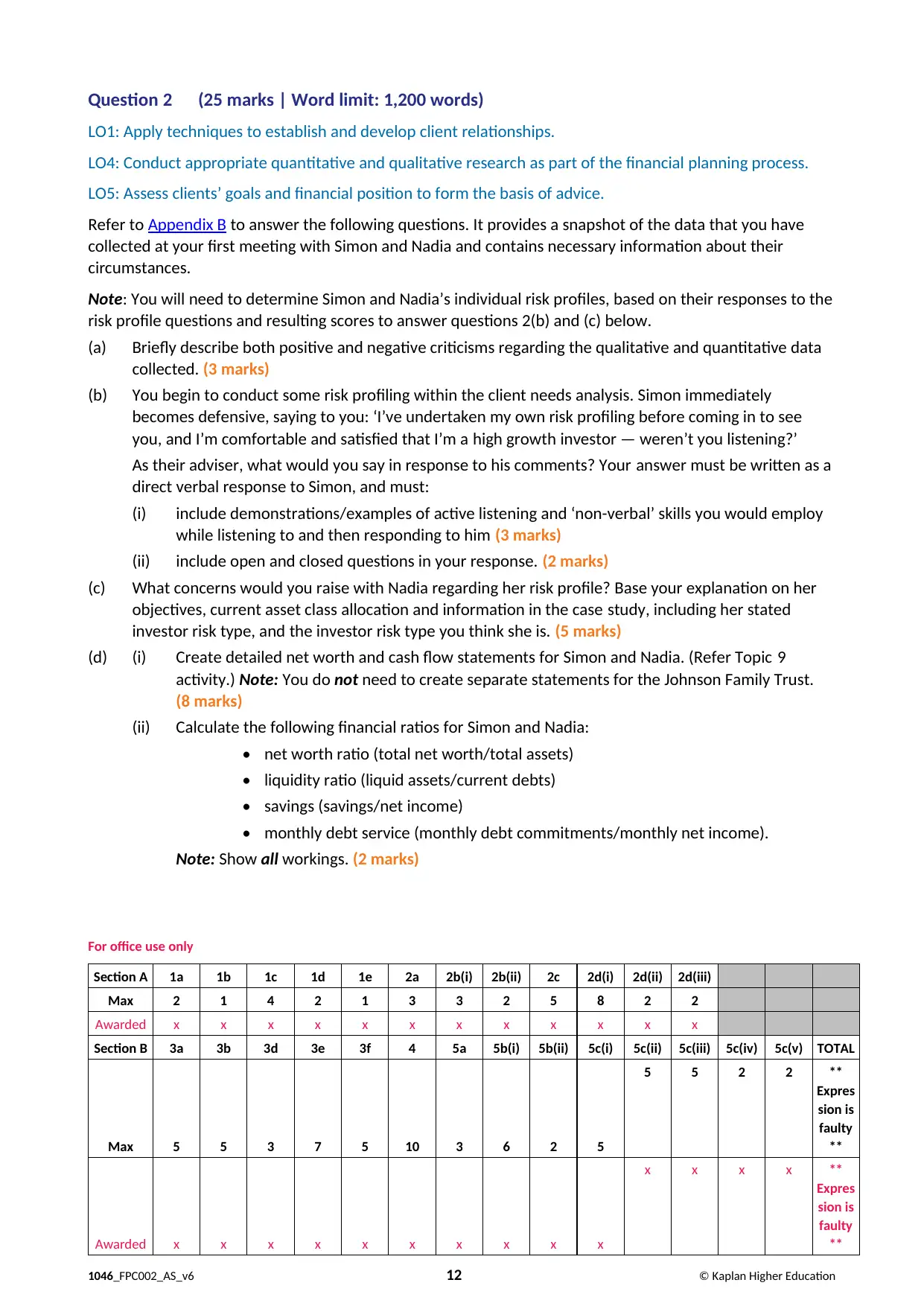
Question 2 (25 marks | Word limit: 1,200 words)
LO1: Apply techniques to establish and develop client relationships.
LO4: Conduct appropriate quantitative and qualitative research as part of the financial planning process.
LO5: Assess clients’ goals and financial position to form the basis of advice.
Refer to Appendix B to answer the following questions. It provides a snapshot of the data that you have
collected at your first meeting with Simon and Nadia and contains necessary information about their
circumstances.
Note: You will need to determine Simon and Nadia’s individual risk profiles, based on their responses to the
risk profile questions and resulting scores to answer questions 2(b) and (c) below.
(a) Briefly describe both positive and negative criticisms regarding the qualitative and quantitative data
collected. (3 marks)
(b) You begin to conduct some risk profiling within the client needs analysis. Simon immediately
becomes defensive, saying to you: ‘I’ve undertaken my own risk profiling before coming in to see
you, and I’m comfortable and satisfied that I’m a high growth investor — weren’t you listening?’
As their adviser, what would you say in response to his comments? Your answer must be written as a
direct verbal response to Simon, and must:
(i) include demonstrations/examples of active listening and ‘non-verbal’ skills you would employ
while listening to and then responding to him (3 marks)
(ii) include open and closed questions in your response. (2 marks)
(c) What concerns would you raise with Nadia regarding her risk profile? Base your explanation on her
objectives, current asset class allocation and information in the case study, including her stated
investor risk type, and the investor risk type you think she is. (5 marks)
(d) (i) Create detailed net worth and cash flow statements for Simon and Nadia. (Refer Topic 9
activity.) Note: You do not need to create separate statements for the Johnson Family Trust.
(8 marks)
(ii) Calculate the following financial ratios for Simon and Nadia:
• net worth ratio (total net worth/total assets)
• liquidity ratio (liquid assets/current debts)
• savings (savings/net income)
• monthly debt service (monthly debt commitments/monthly net income).
Note: Show all workings. (2 marks)
For office use only
Section A 1a 1b 1c 1d 1e 2a 2b(i) 2b(ii) 2c 2d(i) 2d(ii) 2d(iii)
Max 2 1 4 2 1 3 3 2 5 8 2 2
Awarded x x x x x x x x x x x x
Section B 3a 3b 3d 3e 3f 4 5a 5b(i) 5b(ii) 5c(i) 5c(ii) 5c(iii) 5c(iv) 5c(v) TOTAL
Max 5 5 3 7 5 10 3 6 2 5
5 5 2 2 **
Expres
sion is
faulty
**
Awarded x x x x x x x x x x
x x x x **
Expres
sion is
faulty
**
1046_FPC002_AS_v6 12 © Kaplan Higher Education
LO1: Apply techniques to establish and develop client relationships.
LO4: Conduct appropriate quantitative and qualitative research as part of the financial planning process.
LO5: Assess clients’ goals and financial position to form the basis of advice.
Refer to Appendix B to answer the following questions. It provides a snapshot of the data that you have
collected at your first meeting with Simon and Nadia and contains necessary information about their
circumstances.
Note: You will need to determine Simon and Nadia’s individual risk profiles, based on their responses to the
risk profile questions and resulting scores to answer questions 2(b) and (c) below.
(a) Briefly describe both positive and negative criticisms regarding the qualitative and quantitative data
collected. (3 marks)
(b) You begin to conduct some risk profiling within the client needs analysis. Simon immediately
becomes defensive, saying to you: ‘I’ve undertaken my own risk profiling before coming in to see
you, and I’m comfortable and satisfied that I’m a high growth investor — weren’t you listening?’
As their adviser, what would you say in response to his comments? Your answer must be written as a
direct verbal response to Simon, and must:
(i) include demonstrations/examples of active listening and ‘non-verbal’ skills you would employ
while listening to and then responding to him (3 marks)
(ii) include open and closed questions in your response. (2 marks)
(c) What concerns would you raise with Nadia regarding her risk profile? Base your explanation on her
objectives, current asset class allocation and information in the case study, including her stated
investor risk type, and the investor risk type you think she is. (5 marks)
(d) (i) Create detailed net worth and cash flow statements for Simon and Nadia. (Refer Topic 9
activity.) Note: You do not need to create separate statements for the Johnson Family Trust.
(8 marks)
(ii) Calculate the following financial ratios for Simon and Nadia:
• net worth ratio (total net worth/total assets)
• liquidity ratio (liquid assets/current debts)
• savings (savings/net income)
• monthly debt service (monthly debt commitments/monthly net income).
Note: Show all workings. (2 marks)
For office use only
Section A 1a 1b 1c 1d 1e 2a 2b(i) 2b(ii) 2c 2d(i) 2d(ii) 2d(iii)
Max 2 1 4 2 1 3 3 2 5 8 2 2
Awarded x x x x x x x x x x x x
Section B 3a 3b 3d 3e 3f 4 5a 5b(i) 5b(ii) 5c(i) 5c(ii) 5c(iii) 5c(iv) 5c(v) TOTAL
Max 5 5 3 7 5 10 3 6 2 5
5 5 2 2 **
Expres
sion is
faulty
**
Awarded x x x x x x x x x x
x x x x **
Expres
sion is
faulty
**
1046_FPC002_AS_v6 12 © Kaplan Higher Education
⊘ This is a preview!⊘
Do you want full access?
Subscribe today to unlock all pages.

Trusted by 1+ million students worldwide
1 out of 44
Related Documents
Your All-in-One AI-Powered Toolkit for Academic Success.
+13062052269
info@desklib.com
Available 24*7 on WhatsApp / Email
![[object Object]](/_next/static/media/star-bottom.7253800d.svg)
Unlock your academic potential
Copyright © 2020–2025 A2Z Services. All Rights Reserved. Developed and managed by ZUCOL.




